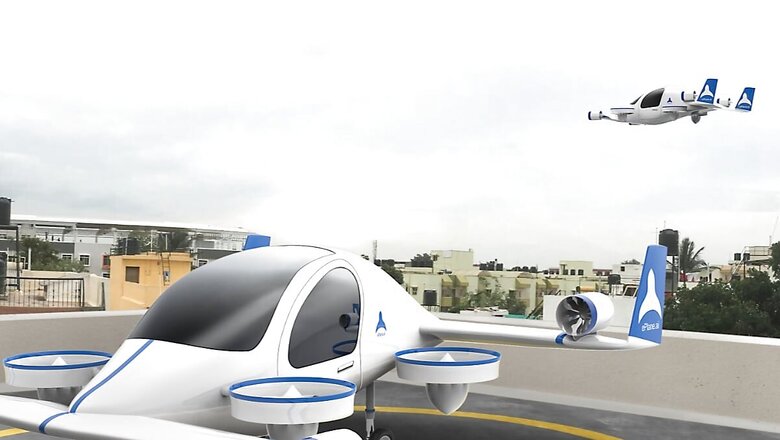Flying Taxis To Cut Travel Time Between Delhi And Gurugram To 7 Minutes? How Will It Work? Explained

views
Metropolitan cities are synonymous to bumper to bumper traffic. But people of Delhi and Gurugram will soon be able to soar above the congested streets in flying taxis covering the distance between the two cities in just 7 minutes.
InterGlobe Enterprises, the owner of IndiGo, and American firm Archer, supported by aircraft giant Boeing, will re-shape the way we travel.
The flying taxis called e-VTOL (electrical vertical takeoff and landing) will be a five-seater aircraft, which will have the comfort of a taxi, with the freedom of flying.
Not only Delhi and Gurugram, flying taxis will also be introduced in Bengaluru city and its international airport, and Bandra and Colaba in Mumbai, and Chennai. The launch is expected in 2026.
How Will It Work?
The 12-rotor ‘Midnight’ model offers both comfort and efficiency, with room for luggage and seating for a pilot and four guests. American carrier United is planning routes between key destinations in the US using the same model.
With Archer anticipating approval from the Federal Aviation Administration (FAA) in the US this year, the prospect of India’s own flying taxi network is not far provided it gets a green light from Directorate-General of Civil Aviation (DGCA).
Nikhil Goel, Archer’s Chief Commercial Officer, said as quoted by The Times of India that the per-passenger cost of these air taxi services is expected to be just a “slight premium” over typical ground transportation options. In fact, with fares likely to hover around 1.5 times the price of an Uber ride, the promise of rapid, hassle-free travel may soon become a reality for urban dwellers in India. “Delhi-Gurugram, for instance, costs Rs 1,500-Rs 2,000 by Uber. An air taxi (per passenger) will cost up to 1.5 times of that or Rs 2,000-Rs 3,000,” he added, as quoted by The Economic Times.
Archer Aviation said the Connaught Place-Gurugram trip would cost Rs 2,000 to Rs 3,000, against Rs 500 in app-based taxi services for the 30-kilometre journey, as per a report by Deccan Chronicle.
What is the Archer Deal?
InterGlobe Enterprises has agreed to purchase 200 Midnight e-VOTLs in a deal valued at $1 billion. According to The Economic Times, IndiGo and Archer plan to collaborate on constructing vertiports, which will include charging facilities, and training pilots.
Archer is starting production of Midnight at its Georgia factory this year. It is collaborating with auto major Stellantis to manufacture air taxis in other locations too, as per The Economic Times report.
InterGlobe Enterprises, which owns nearly 38% of IndiGo-parent InterGlobe Aviation, opens new tab as well as hospitality and logistics businesses, also plans to use the e-aircraft for cargo, logistics, medical, emergency and charter services.
Archer secured a $142 million-deal from the US Air Force in July to provide six Midnight aircraft and said in October it would launch an air taxi service in the UAE.
Air Taxis in Other Countries
Israel had begun conducting tests of autonomous drones that can carry both passengers and cargo. The first test flights of air taxis were part of a government-led pilot project, known as the Israel Drone Initiative (INDI), established in 2019, which aims to create a drone network across the country. The idea is to fly passengers and transport cargo from one place to another and ease traffic congestion on the roads.
Test flights of an autonomous flying vehicle and an electric vertical takeoff and landing (eVTOL) aircraft which can travel long distances were carried out for the first time in a managed urban airspace with heavy cargo loads, according to The Times of Israel.
The electric two-seater vehicles can carry a payload of up to 220 kg and can travel up to 160 km. It has collapsible wings, which makes parking easier and can take off from land or any flat surface.
UAE is set to get flying taxis reportedly by 2027. In February 2023, the ruler of Dubai Sheikh Mohammed bin Rashid Al Maktoum approved the designs of air taxi vertiports from where people can board the cabs.
These flying cars will be able to accommodate four passengers and a pilot. They have a maximum speed of 300 km per hour and will be able to fly about 241 km and emit zero emissions.
US in May last year set up an interagency team to develop a national strategy relating to advanced air mobility efforts such as flying taxis. The US transportation department said the team includes NASA, Transportation Security Administration, Federal Aviation Administration (FAA) and Federal Communications Commission. The first eVTOL is expected to begin commercial operations only by late 2024 or early 2025.
China will start the flying taxi operations for short distance by 2025, middle distance by 2030 and long distance by 2035.
Challenges for Air Taxis
Joe Praveen Kumar, who pioneered the Urban Air Mobility Research at Frost and Sullivan, told CNBC in 2020, “Air taxis are definitely the next phase of mobility… When air taxis become widely commercialised, they will definitely ease the traffic burden on city roads.”
In terms of safety, a CNBC report said while the risk to passengers and those on the ground are to be assessed, it is also important to study the hazard they pose for other aircraft. And hackers can always ready to wreak havoc. Hence, this sector will need regulations that will cover air safety, traffic control, noise pollution, and security.
Pricing could also be another challenge, considering that the niche transport could only be used by the rich. A report by McKinsey said for urban air mobility (UAM) vehicles to become successful, trip prices must fall around 80% from what it costs to currently travel in helicopters. Only then will they be able to compete with ground travel.
What about the infrastructure? Air taxis will need a place to stand, take-off and land. “If a landing spot is too far away from the origin or destination, the customer might not save enough time for a UAM trip to make sense,” the report added.

















Comments
0 comment